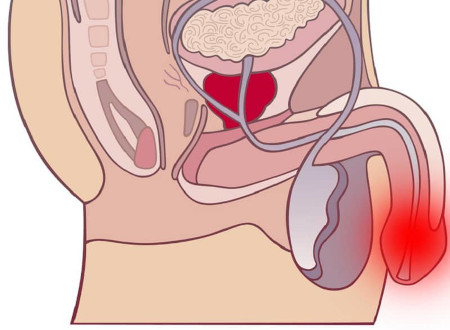Poltava, prospekt Vitaliia Hrytsaienka 9 Weekdays: 8:30-15:00, Weekend: weekend +38 (0532) 56-02-11+38 (095) 688 25 07
Phimosis or short frenulum
 Phimosis and a shortened frenulum of the penis are two unpleasant and even dangerous conditions that many men can face. Despite the fact that both conditions are quite simple to diagnose, patients usually come to the urologist either in severe stages of the course of the disease, or with extremely severe pain.
Phimosis and a shortened frenulum of the penis are two unpleasant and even dangerous conditions that many men can face. Despite the fact that both conditions are quite simple to diagnose, patients usually come to the urologist either in severe stages of the course of the disease, or with extremely severe pain.
Meanwhile, surgical treatment of both phimosis and short frenum of the penis is a rather long and safe procedure, after which the quality of life of patients is significantly improved.
Phimosis is characterized by incomplete or completely absent disclosure of the glans penis. In this case, the foreskin is narrowed and not elastic enough. This condition is often common in newborn boys, and as they grow older, this problem disappears in 90% of children. If incomplete disclosure persists until puberty, consultation with a urologist and further surgical intervention for circumcision of the foreskin is necessary.
When is it diagnosed and why does phimosis appear?
One of the common causes of phimosis is hereditary elastin deficiency, which causes the foreskin to lack elasticity. In addition, various inflammatory diseases in the head region, which are characterized by scarring, contribute to the development of phimosis.
Also, various injuries of the foreskin lead to scarring - for example, those that may arise as a result of independent attempts to get rid of phimosis. This also includes injuries during the first intercourse or masturbation, and even injuries from erection.
During puberty, there may be a discrepancy between the size of the penis and the foreskin, which, for one of the above reasons, cannot stretch sufficiently.
That is why it is important to diagnose phimosis in time and refuse self-medication.
The main symptoms of penile phimosis
The main symptom of this condition is characteristic already in boys of early school age: the impossibility of full disclosure of the head of the penis. This symptom is joined by pain during urination, and later - during erection and during intercourse.
In addition, in some cases, it is possible not only soreness during urine excretion, but also the scarcity of its excretion. This is due to the fact that the foreskin in this state can grow together with the tissues around the urethra, thereby preventing the free passage of urine.
What complications can arise due to phimosis?
Complications resulting from advanced phimosis can be of varying severity. Among them:
- paraphimosis, accompanied by edema, sharp cutting pain in the head of the penis and the impossibility of self-reduction. If you do not provide assistance in time for such a problem, necrosis of the tissues of the penis may develop;
- balanoposthitis is an infectious inflammation of the penis resulting from "stuck" in the area of the closed head of pathogenic microorganisms, urine and sperm. This condition is characterized by an increase in temperature and the presence of purulent and serous-purulent discharge from under the foreskin, and with chronicity of the process, scarring and soldering of the foreskin with the head is possible.
These complications become not only the cause of serious psycho-emotional problems in men, but also can lead to health-threatening problems.
Treatment of phimosis of the penis
In view of the danger of developing serious complications that directly affect the quality of life of a man, as well as his state of health, in the presence of symptoms of phimosis, prompt surgical treatment is indicated.
The operation to remove the foreskin is called circumcision or circumcision. Depending on the stage of the disease, expressed by the severity of its course, complete or incomplete removal of the foreskin is possible, as well as excision of necrotic tissues at the most advanced stage with further reconstructive surgery. Circumcision in most cases does not leave noticeable scars, and the penis does not lose sensitivity after this operation.
Circumcision is also often performed for purely cosmetic purposes, which also helps to improve the patient's quality of life and improve his psycho-emotional state.
What is characteristic of a short frenum of the penis?
 The short frenulum of the penis is characterized by painful tension during intercourse and in general during erection, as well as deformation of the shape of the penis. In this condition, the penis can painfully bend towards the scrotum, which complicates not only sexual activity, but also urination.
The short frenulum of the penis is characterized by painful tension during intercourse and in general during erection, as well as deformation of the shape of the penis. In this condition, the penis can painfully bend towards the scrotum, which complicates not only sexual activity, but also urination.
As a result, sexual dysfunction and subsequent psychological problems develop. In addition, the short bridle can stretch and tear, which is not only extremely painful, but also dangerous due to the possibility of infection.
After the rupture, the defect is not eliminated, but on the contrary, it increases: an adhesion process is formed, as a result of which the bridle contracts even more. Hence follows further depression of erectile function and problems in sexual activity.
Frenulotomy as a way to lengthen the frenum
An operation to lengthen the frenum is called a frenulotomy. This intervention lasts no longer than half an hour and is performed under local anesthesia.
If the patient's condition allows and the bridle was not torn before the operation, the doctor cuts it across, distributes the skin and longitudinally sutures from self-absorbing polymer threads.
In a situation where there is already a history of rupture of the frenum, the doctor performs a frenulotomy with a Z-shaped incision, which loosens the tension of the soft tissues.
At the end of the operation, cosmetic sutures are applied, which are minimally visible after healing.
Immediately after the operation, the patient may feel slight weakness and even mild nausea. This is a normal postoperative condition associated with the body's response to surgery. In this case, it is recommended to restore the balance of electrolytes and glucose in the body by drinking water, sweet tea and eating some sweet and high-calorie foods.
After the operation, the patient is monitored for a short time in a hospital setting, after which he receives further recommendations from the urological surgeon and is discharged. These recommendations include:
- abstinence from masturbation and sexual intercourse until the healing of the postoperative wound and resorption of the sutures;
- refusal from the sauna and bath for the rehabilitation period, which in most cases lasts no more than two weeks.
Strict adherence to all the recommendations of the surgeon after surgery for plastic surgery of the frenum will allow you to avoid complications and heal the postoperative wound as quickly as possible.
specialists of the Clinic for Plastic Surgery
04-06-2021
Similar news
